
Volleyball is a team sport in which two teams of six players are separated by a net. Each team tries to score points by grounding a ball on the other team's court under organized rules. It has been a part of the official program of the Summer Olympic Games since Tokyo 1964. Beach volleyball was introduced to the programme at the Atlanta 1996 Summer Olympics. The adapted version of volleyball at the Summer Paralympic Games is sitting volleyball.

Dodgeball is a team sport in which players on two opposing teams try to throw balls and hit opponents while avoiding being hit themselves. The objective of each team is to eliminate all members of the opposing team by hitting them with thrown balls, catching a ball thrown by an opponent, or inducing an opponent to commit a violation, such as stepping outside the court.
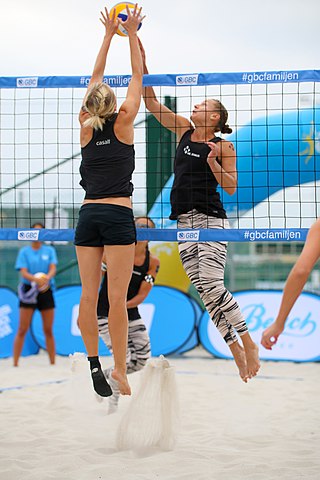
Beach volleyball is a team sport played by two teams of two players each on a sand court divided by a net. Similar to indoor volleyball, the objective of the game is to send the ball over the net and to ground it on the opponent's side of the court. Each team also works in unison to prevent the opposing team from grounding the ball on their side of the court.
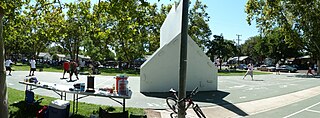
American handball, known as handball in the United States and sometimes referred to as wallball, is a sport in which players use their hands to hit a small, rubber ball against a wall such that their opponent(s) cannot do the same without the ball touching the ground twice or hitting out-of-bounds. The three versions are four-wall, three-wall and one-wall. Each version can be played either by two players (singles), three players (cutthroat) or four players (doubles), but in official tournaments, singles and doubles are the only versions played.

In basketball, the basketball court is the playing surface, consisting of a rectangular floor, with baskets at each end. Indoor basketball courts are almost always made of polished wood, usually maple, with 3.048 meters (10 ft)-high rims on each basket. Outdoor surfaces are generally made from standard paving materials such as concrete or asphalt. International competitions may use glass basketball courts.
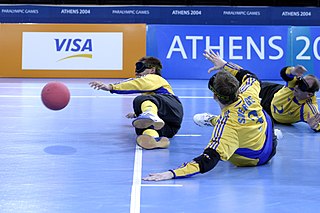
Goalball is a team sport designed specifically for athletes with a vision impairment. Participants compete in teams of three, and try to throw a ball that has bells embedded inside of it into the opponents' goal. The ball is thrown by hand and never kicked. Using ear-hand coordination, originating as a rehabilitation exercise, the sport has no able-bodied equivalent. Able-bodied athletes are also blindfolded when playing this sport.

Tchoukball is an indoor team sport, played by teams of 7 players. It was developed in Switzerland in the 1970s, and is most popular in Singapore, Switzerland and Taiwan, but has become an international sport with national federations in over 60 countries. It is governed by the International Tchoukball Federation (FITB), which was founded in 1971.
Extreme Dodgeball is an American game show based on the game of dodgeball that aired between 2004 and 2005 on the Game Show Network. The series ran for three seasons, each of which featured six to eight teams of five to seven players. The first series followed gimmick teams, such as sumo wrestlers and jockeys, which changed over time into the third series with franchise-like teams representing cities. All three series are presented by Bil Dwyer and Zach Selwyn.
Flickerball is a group sport played with an American football in similar situations to dodgeball, such as Gym Class/PE classes. It is played in a group of 6 to 40 players who are equally divided into two teams. The teams separate on opposite sides of an area such a gymnasium, parking lot, or field. The game is unstructured in terms of what constitutes or if there will be outs and the length of play nor time-outs. There are many rules and the game is structured most similarly to Ultimate Frisbee. One notable exception is that any shot on goal results in the ball going out of bounds which results in an automatic change of possession. This rule should mitigate wild shots hoping for statistical points.
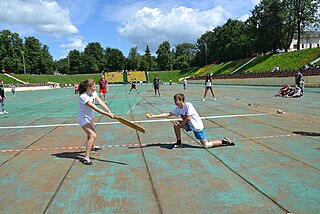
Lapta is a Russian bat-and-ball game first known to be played in the 14th century. Mentions of lapta have been found in medieval manuscripts, and balls and bats were found in the 14th-century layers during excavations in Novgorod.

Fistball is a sport of European origin, primarily played in the German-speaking nations of Austria, Germany and Switzerland, as well as in Brazil. The objective of the game is similar to volleyball, in that teams try to hit a ball over a net, but the rules vary from volleyball in several major ways. The current men's fistball World Champions are Germany, winners of both the 2023 Men's World Championships and the fistball category at the 2022 World Games, while the current women's fistball World Champions are also Germany, after winning the 2021 Women's World Championships.

Newcomb ball (also known simply as Newcomb, and sometimes spelled Newcombe (ball)) is a ball game played in a gymnasium or court using two opposing teams and a net. Newcomb ball and the sport of volleyball were both created in 1895 and are similar in their design. The sport rivaled volleyball in popularity and participation by the 1920s. The sport of throwball may be a possible relative.
Machanayim is a game similar to dodgeball that is frequently played in North American Jewish schools and summer camps. The name Machanayim comes from the Hebrew word meaning "two encampments" or, in this case, two teams.

The National Dodgeball League (NDL) is the only professional dodgeball league in the United States. The league was founded in 2004 and is currently headed by Commissioner Edward Prentiss out of Hopkins, MN. The league is composed of 24 professional teams, which are divided into the National and the American Dodgeball Conferences. In addition to professional dodgeball, the NDL hosts the annual amateur Dodgeball World Championship (DWC) in Las Vegas, Nevada. The DWC draws dodgeball players from across the globe to compete in a tournament to determine the best amateur dodgeball team in the world. Prior DWC tournaments have included teams from Canada, Denmark, United Kingdom, Japan, New Zealand, and Australia.
Prisonball is played much like the original dodgeball game, except when a player is hit, they get put in "prison" behind the opposing team. To get out of prison, the player needs to receive a pass from a teammate while in the designated prison area. The way in which prisoners are released varies by region. "Prisoners" remain behind the opposing team until the game is over or they're released according to the current ruleset.
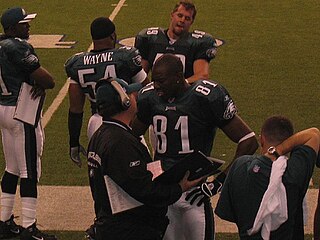
In sports, out of bounds refers to being outside the playing boundaries of the field. The legality of going out of bounds, and the ease of prevention, vary by sport. Sports that use this term include American football, Canadian football, field lacrosse, basketball, rugby union, rugby league, and association football.

Ringball is a traditional South African sport that stems from basketball and has been played since 1907. The sport is now promoted in South Africa, Namibia, Botswana, Lesotho, India, and Mauritius to establish Ringball as an international sport. The sport is played by both men and women teams.
Volleyball drills are specialized exercises that enhance teams and players volleyball skills. There are numerous volleyball drills that teams and players can utilize in order to improve and further develop their skills in all areas of the game such as passing, serving, attacking, setting, blocking, and digging. From beginners to well-seasoned players, drills can help all players gain repetitions in various skills and positions; the more repetitions, the better a player can become.
This glossary provides definitions and context for terminology related to, and jargon specific to, the sport of pickleball. Words or phrases in italics can be found on the list in their respective alphabetic sections.













